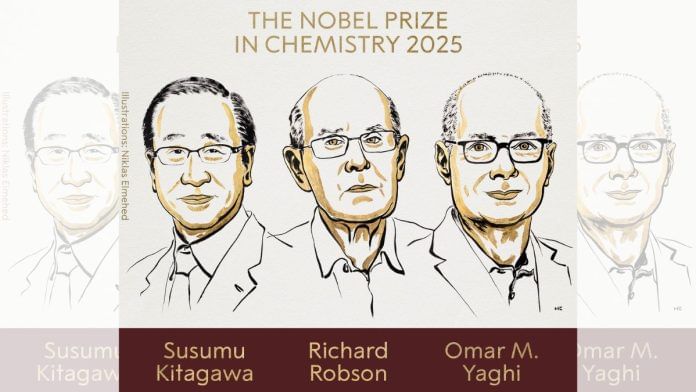New Delhi: Chemists Susuma Kitagawa, Richard Robson and Omar M. Yaghi have been awarded the Nobel Prize in Chemistry 2025 for their development of ‘metal-organic frameworks’ (MOFs).
MOFs are a new kind of crystalline materials that combine properties of metals and organic compounds for a variety of applications, from harvesting water molecules from dry desert air to separating CO2 from air.
“This year’s (Nobel) prize is about creating new rules for chemistry—with new materials that have unheard of properties,” announced Hans Ellegren, secretary general of the Royal Swedish Academy of Sciences, which awards the Nobel Prizes in Physics and Chemistry.
The Nobel Prize in Chemistry this year has been awarded to scientists who revolutionised the fundamental understanding of solid materials. The awardees pioneered a new method of building chemical compounds by manipulating the molecules of solids, such as metals, to behave like porous gas molecules at the molecular level. These metal compounds have large cavities inside them to allow for gases to pass through.
What this new range of MOFs has done is open up the field of chemistry to new possibilities using porous, flexible and functional solid materials. They have, quite literally, been used to create water from thin air.
“These MOFs can be used, among other things, for materials that can harvest water molecules from dry desert air, or materials that can separate CO2 from air, or even absorb toxic gases and convert them to harmless substances,” said Heiner Linke, the Chair of the Nobel Committee for Chemistry, during the announcement.
Richard Robson, a professor at the University of Melbourne in Australia, began the initial research into MOFs back in 1974 while teaching classes on molecules. His idea was to use atoms to link together different types of molecules and build a different class of structures altogether.
This idea was further developed by Susuma Kitagawa at Kyoto University in Japan in 1992, when he began building porous molecules that could accommodate different gases inside. In 1997, he had a breakthrough by building a metal-organic framework that used cobalt or zinc metals and could even accommodate gases like nitrogen, oxygen and methane.
“I’m deeply honoured and delighted that my long-standing research has been recognised,” said Kitagawa on a phone call in the Nobel press conference. “I’m very interested in seeing the usefulness of this material for society, but it also helped me discover new properties so it was fun for me!”
Omar Yaghi, a professor at the University of California, Berkeley, was working at the same time as Kitagawa to build solid materials with different components, almost like LEGOs. Yaghi was the first to coin the term ‘metal-organic framework’ to refer to the material he had created.
While it had base properties of metal, i.e. it was solid and had metal ions, these ions were linked together using organic molecules like carbon, which allowed for a flexible porous structure through which gases could pass.
“A small amount of such MOFs can be like Hermione’s handbag in Harry Potter, it can store huge amounts of gas in a tiny volume,” explained Linke in the press conference. “These MOFs can be created with unlimited variations and unending possibilities.”
The award-winning MOFs have been used by scientists across the world for different purposes, including to literally create water from desert air in Arizona. Given their huge gas-storing properties, MOFs have also been proposed for use in industries that produce toxic substances, to reduce the impact of these gases on the environment.
Other applications for MOFs include treating wastewater, removing crude oil from polluted water, absorbing carbon dioxide for carbon capture purposes, and mining rare-earth elements from wastewater.
The Nobel Prize for Chemistry has been awarded continually from 1901 to 2024, with a total of 116 Chemistry Nobel prizes awarded to 195 individuals. One of these prizes, in 2009, was awarded to Venkatraman Ramakrishnan, an Indian-origin scientist from the United Kingdom.
Ramakrishnan, along with two other scientists, was awarded the Nobel Prize in Chemistry “for studies of the structure and function of the ribosome”.
As a scientist, Alfred Nobel’s own contributions to science were also in the field of chemistry as he is credited with inventing dynamite, the explosive that went on to change the industrial and defence world. In his will, announcing the creation of the Nobel Prizes in 1896, Chemistry was the second prize mentioned.
(Edited by Amrtansh Arora)
Also Read: How 3 scientists who won physics Nobel brought ‘quantum physics from subatomic world onto chip’






